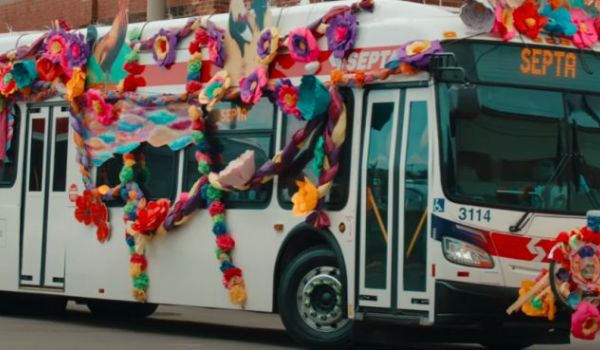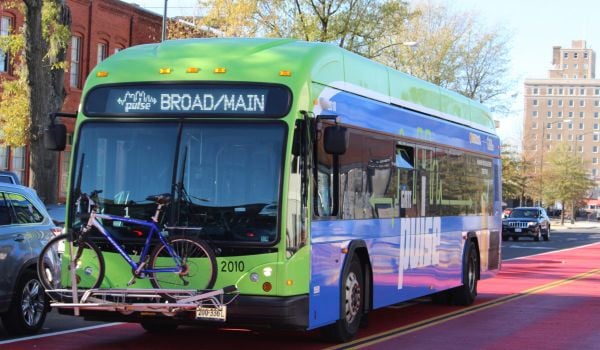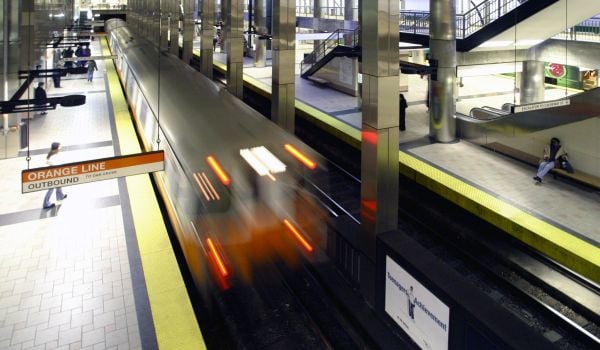Last month, Tucson suffered a case of missing bus lanes.
Unlike the protected bike lanes that tend to disappear, Broadway Boulevard’s transit right-of-ways weren’t actually on the ground — yet. They were only blueprints, recommended by a citizen’s task force and approved by city council.
They were supposed to flank the boulevard, for which voters approved an expansion in 2006 as part of a $2.1 billion regional tax. That package promised to widen the arterial from four lanes to eight (six for cars, two for transit) but, faced with falling traffic counts and the destruction of street-side homes and businesses, a city-convened task force slimmed those eight lanes to six (four for cars, two for transit). On October 10th, Tucson officials announced that city council had approved the plan.
But when the task force reconvened on March 19th, the bus lanes were gone. The city’s recommended design featured six lanes, all of them for cars. A press release from December 11th, issued by the Regional Transportation Authority (RTA) funding the project, mentions six lanes with bus pullouts — but no right-of-ways.
“The dedicated transit lanes got stripped out — and no one’s really explained how or where that recommendation was made,” says Colby Henley, a member of the task force. “They were taken out behind the scenes.”
That’s not the case, says Beth Abramovitz with Tucson’s DOT, stating that the lanes got lost in translation between the task force and city officials.
“Our takeaway was that they wanted a placeholder for transit, not transit from day one,” she says.
But though several new plans were proposed at a March 26th meeting, and the task force approved a blended version, the new blueprint still doesn’t feature a bus-only lane. It does include a “transit alignment,” which Henley explains as leaving the door open for transit when the city’s mayor and council deem appropriate. But, unlike that first set of plans, it’s not a lane.
Henley believes the city dropped the right-of-ways to appease the RTA, set up in 2006 when voters approved the funds financing Broadway’s expansion.
Jim DeGrood, RTA’s deputy director, also denies any kind of out-of-the-public-view discussion. But he says that the organization does want to stay close to what the public approved in 2006.
“When RTA was set up, the biggest concern that the public had was a lack of confidence that the projects that they had voted for would be executed,” he says. “We want to honor what the voters voted for.”
“We also recognize that the world isn’t static,” he says, acknowledging that Broadway’s EIR was finalized in 1987. Traffic along that street is declining, not rising, though DeGrood questions whether the recent lows come from construction projects that have closed nearby streets.
Bottom line: RTA approved six lanes with bus pullouts, not the eight lanes with dedicated transit voted on in 2006, not the six lanes with dedicated transit proposed by the task force.
“Times may change,” he says, adding that when the region decides to invest in a high-capacity transit system, RTA may “support the conversion of travel lanes in either direction to transit use.”
But although the task force approved a new plan with placeholders for transit, Henley questions when exactly those lanes will materialize.
“If the RTA has their say on how this road is funded, do they have veto authority?” he asks. “What happens if the city does decide to change [the lanes] — could the RTA come back and say ‘We paid for this road’?”
His question hints at a deeper one about the region’s structure.
“The whole dynamic is that the RTA is holding these funds, and yet [the project] is wholly within city limits,” he says. “The city’s task force is telling them to do it a certain way, but they have to please the county for the sake of regional funding.”
It’s an issue that comes up often when county-wide funds target both urban and suburban projects. Boise’s bike lane that died less than two months after installation (which I’ve written about here and here) provides a good example. But, unlike Ada County in Idaho, Pima County voters don’t seem opposed to multimodal projects. That $2.1 billion plan proposed funds for a streetcar, bus services, bike lanes and pedestrian amenities.
“My tax is balanced,” says DeGrood, when I ask about multimodal priorities. “Every single roadway element project has bike lanes, sidewalks and bus pullouts. We provide for these systems.”
Still, the jury is out on those lanes that disappeared. And the jury is out on when — or whether — they’ll be back.
The Works is made possible with the support of the Surdna Foundation.

Rachel Dovey is an award-winning freelance writer and former USC Annenberg fellow living at the northern tip of California’s Bay Area. She writes about infrastructure, water and climate change and has been published by Bust, Wired, Paste, SF Weekly, the East Bay Express and the North Bay Bohemian
Follow Rachel .(JavaScript must be enabled to view this email address)

















